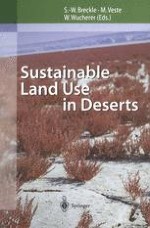2001 | OriginalPaper | Chapter
Arid Rangeland Management Supported by Dynamic Spatially Explicit Simulation Models
Authors : Florian Jeltsch, Thomas Stephan, Thorsten Wiegand, Gerhard E. Weber
Published in: Sustainable Land Use in Deserts
Publisher: Springer Berlin Heidelberg
Included in: Professional Book Archive
Activate our intelligent search to find suitable subject content or patents.
Select sections of text to find matching patents with Artificial Intelligence. powered by
Select sections of text to find additional relevant content using AI-assisted search. powered by
In arid regions, the effects of grazing management on natural communities of long-lived plants generally take years or even decades to become evident. Event-driven dynamic behaviour, disturbances, unpredictable and low rainfall and complex interactions between species make it difficult to gather sufficient understanding of vegetation dynamics for developing guidelines for sustainable management of arid rangelands. This is further complicated by the importance of spatial scales and patterns, e.g. patchiness of rainfall, heterogeneous grazing behaviour of domestic livestock or distances between artificial watering points.Simulation models that consider the essential processes determining vegetation dynamics offer scope for quantitatively exploring long-term vegetation dynamics of arid rangelands. If these models are spatially explicit, they additionally allow for the investigation of spatial processes, such as competition or dispersal, and patterns such as landscape features or structures imposed by management (boreholes, paddocks etc.).This chapter, discusses the promises and limitations of spatially explicit simulation models as (often neglected) tools for rangeland management. We focus on model examples from rangelands in southern Africa, namely a set of models simulating cattle grazing in the southern Kalahari and a model simulating a karakul sheep farm at the border of the Namib desert (Namibia).Results of the Kalahari models show the existence of a grazing threshold that determines the long-term sustainability of livestock grazing. This threshold depends on rainfall, grazing intensity and grazing heterogeneity. Its effect is illustrated with the spatial vegetation dynamics around artificial watering points. The model of the karakul sheep farm is used to investigate a successful example of sustainable rangeland management under harsh conditions.
